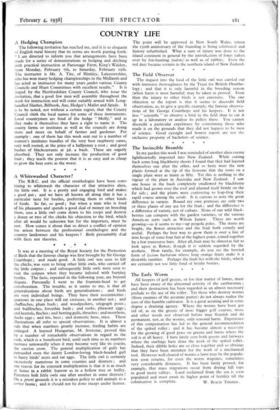The Invincible Bramble
In my garden this week I was reminded of another alien enemy lightheartedly imported into New Zealand. While cutting back some long blackberry shoots I found that they had layered themselves one after the other, and so lusty were the new plants formed at the tip of the festoons that the roots on a single plant were as many as fifty. Yet this is nothing to the vigour of the plant in Australia and New Zealand. I saw one house in the bush completely swallowed by blackberry which had grown over the roof and planted itself firmly on the far side ; and the plants were continuing to leap-frog their rapid course among the scrub. It is curious to note the great difference in variety. Round my own premises are only two or three plants of any use for the fruit ; and the difference is a difference of variety, not of culture. None of our wild black- berries can compare with the garden varieties, or the various American sorts such as Wilson Junior. These are worth growing—as it seems to me—up pergola poles. The stems are bright, the flower attractive and the fruit both comely and useful. Perhaps the best way to grow them is over a line of iron hoops of some four feet at the highest point, joined together by a few transverse bars. After all, fruit may be almost as fair to look upon as flower, though it is seldom regarded by the aesthete. How rarely, for example, do you see the berried form of lycium barbarum whose long orange fruits make it a desirable rambler. Perhaps the fault lies with the birds, which are certainly not too little fond of bright berries.














































 Previous page
Previous page